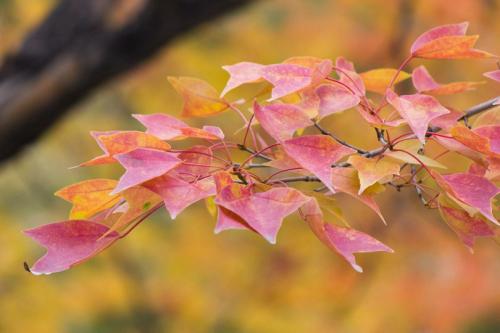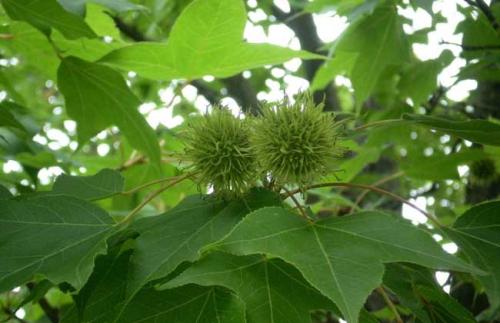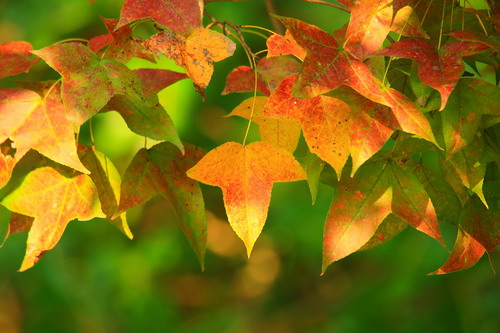Chinese sweet gum (Liquidambar formosana) profile
Written by Maggie
Mar 31 2021

Chinese Sweet Gum (Liquidambar formosana), also called Formosan gum, is a deciduous tree with a height of 30 meters and a maximum diameter of 1 meter at breast height. Chinese Sweet Gum bark is grayish brown. Chinese Sweet Gum likes a warm and humid climate, like light, drought tolerance barren. Chinese sweet gum trees can be used as street trees because of their beautiful appearance and red leaves, and have a very high height.
Provinces south of the Qinling and Huai rivers of China, also found in northern Vietnam, Laos and southern Korea.
Chinese sweet gum picture

Morphological characteristics of Chinese sweet gum
Chinese Sweet Gum is a deciduous tree with a height of 30 meters and a maximum diameter of 1 meter at breast height. Its bark is grayish brown with peeling square blocks. Branchlets are gray after pilose, slightly lenticellata; Buds are ovate, ca. 1 cm long, slightly hairy, scaly bracts covered with resin, brown black, glossy after drying.
Chinese Sweet Gum leaves are thinly leathery, broadly ovate, palmately 3-lobed, central lobes longer, apex caudate acuminate; Bilateral lobes are spreading; Base is cordate; Green above, grayish green after dry, not shiny; Pubescent below, or bald with hairs only between vein axils; chinese sweet gum has 3-5 palmate veins, prominent on both upper and lower sides, reticulate veins visible; The edge is serrated and the tip of tooth has a glandular process; Petiole is up to 11 cm, often pubescent; Stipules are linear, free, or slightly contiguous with petiole, 1-1.4 cm long, reddish-brown, hairy, caducous.
Chinese Sweet Gum (Liquidambar formosana) are often arranged in racemes, stamens numerous, filaments unequal in length, anthers slightly shorter than filaments. Female heads with 24-43 flowers, petioles 3 -- 6 cm long, occasionally lenticellata, without glands; Calyx teeth 4-7, needlelike, 4-8 mm long, lower part of ovary concealed in head axis, upper part free, pubescent, style 6-10 mm long, apex often curled. Inflorescences of Chinese Sweet Gum are capitate globose, woody, 3-4 cm in diameter. The lower half of the capsule is hidden in the axis of inflorescence, with persistent style and needle-like calyx teeth. Seeds are numerous, brown, polygonal or narrow-winged.
Chinese Sweet Gum (Liquidambar formosana) is conical in shape, about 20-40 meters in height, up to 40 meters in height, and the maximum diameter at breast height is more than 1 meter. Young and middle-aged bark are pale gray, smooth, old bark grayish brown, rough and thick, shallow longitudinal furrow, square block peeling; Branchlets are gray, pilose, slightly lenticellata, grayish after dry; Buds are elliptic ovate, slightly brown pilose, ca. 1 cm long; Chinese Sweet Gum has 5-6 scaly bracts, often resinous, brown black after drying, lustrous.
Leaf
Leaves of Chinese Sweet Gum (Liquidambar formosana) are simple alternate or fascicular branches, cordiform or broadly ovate-triangular, thinly leathery, palmately 3-lobed or 5-7 lobed triangular when young and unlobed ovate, lobes on both sides shorter, spreading, apically caudate acuminate; Central lobe is longer, ovate or ovate-triangular, apical caudate acuminate or acuminate; Base is slightly cordate, cordate, or truncate; The surface is green, bright, grayish green after dry, not shiny, the color changes with the season, turning yellow in autumn to red when leaves fall in the following spring; Dorsal of Chinese Sweet Gum is glabrous or pubescent when young, glabrescent, pubescent only along main veins or vein axils; Chinese Sweet Gum has 3-5 palmate veins, surface and dorsal surface are obvious, reticulate vein is obvious; Leaf margin is serrate, apex glandular, 6-13 cm long, 6-15 cm wide. Petiole is terete, often pubescent, ca. 3-12 cm long; Chinese Sweet Gum has 3 stipules, linear, reddish brown, pilose, free or slightly connate with petiole, caducous, ca. 1-1.5 cm long. Leaf after rubbing after guava aroma.
Flowers
Flowers of Chinese Sweet Gum (Liquidambar formosana) are unisexual, monoecious, heteroecious, without perianth; The male flower was arranged into a racemose type by the short spike and human catkin or head inflorescence, and it was pale yellowish green and terminal, with black scales, and seemed to have hair, no petals and calyx. The stamens were in majority and the filaments were not uniform in length, and the anther was red and slightly shorter than the filaments. Female flowers of Chinese Sweet Gum are globose heads with black scales, apetalous, each with 22-43 flowers, ca. 1.5 cm in diameter; Peduncle is slender, peduncle occasionally lenticellata, glandular absent, ca. 3 -- 6 cm long; Calyx teeth 4-7, needle-shaped, ca. 4-10 mm long; Ovary is 2-loculed, ovules numerous in each locule, lower part hidden within the inflorescence axis, upper part free, style pilose; Style is 2-forked, stigma often curled, purplish red, ca. 6 -- 10 mm.
Fruit
Fruit of Chinese Sweet Gum (Liquidambar formosana) is a capsule, composed of several capsules aggregated into a capitate fruit inflorescence, round, densely spines starlike, shaped like a meteor hammer, woody, with persistent style ca. 2.5-5 cm in diameter; There were 22-43 fruits in each inflorescence. 2 valves are dehiscent, 2-lobed, lower part concealed within woody inflorescence axis, style persistent and spiny calyx teeth. Seeds of Chinese Sweet Gum are elliptic, numerous, flat, polygonal, membranous and narrow winged, dark brown when mature.
The ecological habits of Chinese sweet gum
Chinese Sweet Gum (Liquidambar formosana) likes warm and humid climate, sex like light, saplings slightly shade resistance, drought resistance barren soil, not waterlogging resistance. More than born in the ground, near the village, and low mountain secondary forest.
Chinese Sweet Gum (Liquidambar formosana) grows well on moist, fertile and deep red and yellow loam with deep roots, thick and long taproots, strong wind resistance, and not resistant to transplantation and pruning.
The seeds of chinese sweetgum have the habit of germinating every other year. They are not cold resistant, and can not overwinter on the open ground in the north of the Yellow River, and can not tolerate salt, alkali and drought. It is the dominant species of secondary forest in Hainan Island. Chinese Sweet Gum (Liquidambar formosana) is resistant to fire and has strong germinating power.
Chinese Sweet Gum (Liquidambar formosana) is a positive plant, which likes sunshine, shade tolerance, fire resistance, toxic gas and wind cold resistance. It is distributed in valleys, hillsides, secondary forests or the banks of streams and rivers below the altitude of 2000 meters. Chinese Sweet Gum has deep roots and likes to grow in moist and fertile acid and neutral loam, and can also grow in sticky yellow soil or sandy gravel soil.
How to grow and care for Chinese sweet gum
Watering
Chinese Sweet Gum (Liquidambar formosana) has large leaves and fast evaporation of water. In the growing season, it should be watered frequently. In hot weather, water should be sprinkled on the ground frequently to keep the microclimate moist. Chinese sweet gum in winter into a dormant period, to water less, as long as the pot soil is moist do not water.
Fertilization
Chinese Sweet Gum (Liquidambar formosana) in spring before germination and leaves, should be applied once respectively, but do not fertilize on rainy days. In summer to apply a ripe thin liquid fertilizer. Do not apply fertilizer during the winter dormant period.
Trimming
Chinese Sweet Gum (Liquidambar formosana) has strong germination power and often grows new buds on the trunk. Any buds and overdense branches that are not needed for shape should be cut off in time. This can not only save nutrition, but also facilitate ventilation and light transmission. The best viewing period of Chinese sweet gum is when the new leaves are just put out. If all the leaves are removed at the end of summer and the new leaves can be grown in about 20 days with the application of decomposable and thin liquid fertilizer, the best viewing period is added again.
The propagation mode of Chinese sweet gum
Chinese Sweet Gum (Liquidambar formosana) can be propagated in winter or spring, and is usually sown by means of drill sowing or broadcast sowing.

Disease control of Chinese sweet gum
Chinese Sweet Gum (Liquidambar formosana) seedlings have strong adaptability, so it is not easy to cause pests and diseases. But in the first uncovering grass, because the seedlings grow more tender, there are short - term disease and insect occurrences. Suitable agents can be selected for spraying 7d after uncovering the grass. Generally, chlorothalonil 2000 times liquid can be used. Spray chlorothalonil 1000 times solution or carbendazim 800~1000 times solution once 20~30 days later; When pests occur, methamidophos 1000 times solution can be sprayed for control. During the growth of Chinese Sweet Gum seedlings, soil and weeding should be done well. Because sweetgum seedlings are sensitive to herbicides, when grass damage occurs, artificial weeding is generally adopted, and herbicides cannot be used.
Remove the dead branches and leaves on the afforestation ground, eliminate the source of diseases and insects; To build mixed forest and improve the ecological environment of woodland; Remove pests, destroy pests habitat environment: scientific fertilization, reasonable thinning. The following methods should be used to control the brown caterpillar:
(1) Artificial cocoon;
(2) To protect natural enemies, the cocoon picked in the wild has been parasitic pupae, pick out and put back to the forest or not pick:
(3) Chemical control, with 25% show urea Ⅲ # 3500 times liquid, or kill chrysanthemum ester 2000 times liquid, 20% or 25% deltamethrin 2000 times liquid, and 40% omethoate 800 times liquid, with mobile spray canopy sprayer in the evening, the control effects were over 90%. Pyrethroid liquid can also be used to spray into the screen, the prevention effect of more than 95%;
(4) The poison rope method, with 20% phenothrin and oil according to 1:8 mixed adjustment, paper rope soaked for 0.5h, out to dry and tied to the trunk chest high, the prevention and control effect in 90%;
(5) Light lures moths, the effect of luring the adult moth is better when the lamp is set in the forest land with more serious harm.
The variety classification of Chinese sweet gum
1. Halfway maple (Acer japonica, Colour wood)
Deciduous trees, up to 20 cm tall. Bark thin, branchlets often milky.Leaves simple opposite, lobes to 7 -- 15 cm in diameter, usually palmately 5-lobed, base often cordate-shaped, lobes ovate-triangular, entire, both surfaces glabrous or tufts only in lower vein axils.Flowers miscellaneous, corymbium terminal. Fruit flat, fruit wings open into pure horn, wing length for nut 2 times. Mainly produced in the Yangtze River Basin, southwest, north China and northeast of the south, west to Sichuan, Shaanxi is the most widely distributed.
2. Acer chickenfoot (Acer chickenfoot, Cyanosperm)
Deciduous small trees, up to 7 cm - 8 cm high, canopy umbrella-shaped or spherical, branchlets fine, purple or grayish purple. Leaf blade diameter 6 cm -- 10 cm, palmately 5 cm -- 7 cm deeply lobed, usually 7 deeply lobed, lobes ovate-oblong to lanceolate, margin with fine double serrate, below only vein axils tufted hairs, flowers miscellaneous, purplish red. Fruit globose, two fruit wings spread at right angles to obtuse angles, purplish red when young, brownish yellow when mature. Mainly distributed in eastern and central China.
3. Yuan Baofeng (Acer vulgaris)
Deciduous trees, up to 10 m tall. Crown umbellate or obob broadly ovate. Leaves palmately 5-lobed, lobes entire, lobes acute Angle between.Leaf base usually truncate. The stone is flat, the wings are spread at about right angles, the wings are wider, equal to or slightly longer than the nutlet. Mainly produced in North China and the southern northeast area, Inner Mongolia, Shaanxi, Shandong, Jiangsu, Anwei also have distribution.
4. Triangle Maple (Arya Maple, Chicken Maple)
Deciduous trees up to 20 m tall with flaking bark and ovate crown. Leaf apex 3-lobed or unlobed, entire or slightly sparsely shallowly serrate. Fruit raised on both sides, two fruit wings nearly parallel. Produced throughout the Yangtze River Basin, North China, South China, Southwest China has been cultivated.
5. Camellia acer [North China tea stick]
Deciduous shrubs or small trees. Leaf blade usually 3(a 5) pinnated, middle lobes prominent, both sides straight or inconspicuous, split margin irregularly notched doubly serrate, pinnate veins, base triplicate. Fruit on both sides protruding, fruit wing long for the fruit body 2 times, upright into an acute Angle, inner margin more overlapped. Production of Northeast, North China, subspecies bitter tea, produced in the middle and lower reaches of the Yangtze River basin.
6. Compound Acer (Acer cereus, Acer sugar)
Deciduous trees, up to 20 m tall. Branchlets green, glabrous. Oddly pinnate compound leaves, leaflets 3 -- 7(9), ovate to long elliptic lanceolate, margin irregularly incised, terminal leaflets often 3-lobed. Flowers unisexual heterotropies, male inflorescences cymbiform, female inflorescences racemose. Fruit wings long and narrow, open into an acute Angle or right Angle. Originally produced in North America, China's East, Northeast, North China has been introduced to cultivation.
The distribution area of Chinese sweet gum
Chinese Sweet Gum (Liquidambar formosana) is native to eastern Canada and the United States. It can be grown in China as far north as Heilongjiang Province, and as far south as northern Jiangsu, Anhui and Hubei provinces.
Chinese Sweet Gum (Liquidambar formosana) is produced in provinces south of the Qinling Mountains and Huaihe River, from Henan and Shandong in the north, to Taiwan in the east, to Sichuan, Yunnan and Xizang in the west, and to Guangdong in the south.Also found in northern Vietnam, Laos and southern Korea.
Chinese Sweet Gum (Liquidambar formosana) is distributed in Hainan, Guangxi, southeastern Yunnan, Guangdong, Hong Kong, Fujian, Hubei, Sichuan, Jiangsu, Henan, Shaanxi, Gansu and other provinces in China.
Function and use of Chinese sweet gum
The economic value
Chinese Sweet Gum (Liquidambar formosana) wood is slightly stronger and can be used for creating furniture and valuable goods. The branches and stems can be used to grow mushrooms. The wood is hard and termite resistant, making it a good material for construction and furniture. The leaves can be used as bookmarks after the leaves are pressed dry. Capsules can be dried after the material for drying flowers.In addition, its wood can be used as materials for construction and woodworking.
Spices role
Resin has a fragrance and can be used to mix spices. The resin of Chinese Sweet Gum (Liquidambar formosana) is called "white gum fragrance", and the resin of a shexiang tree is called "shexiang".
Ornamental value
Chinese Sweet Gum (Liquidambar formosana) can be used as street trees because of their beautiful appearance and red leaves, and have a very high height.
Potted value
Spring and summer shade cover the sky, and Chinese Sweet Gum (Liquidambar formosana) can be used as street trees, garden trees or bonsai tree species.

Latest Updated
- Benefits of Bugleweed - 7 Science-backed Health Benefits
- Bugleweed Dangers & Side Effects - Is It Poisonous?
- How to Plant Evergreen Trees - What You Should Know
- When to Plant Evergreens - Grow Guide for Evergreen Trees
- 12 Wonderful Evergreen Shrubs for Your Garden
- 12 Popular Evergreen Plants with Pictures for Beginners
- When And How To Prune A Lilac Bush Like a Pro
- How to Grow & Care for Lilac Vine (Hardenbergia Violacea)
- Japanese Lilac Tree (Syringa Reticulata) Care & Propagation Guide
- Shumard Oak Pros and Cons - What to Know
Popular Articles
- Winter maintenance of Antirrhinum Majus
- How to Grow Terminalia Mantaly Tree
- How to Grow and Care for Crossostephium Chinense
- How to grow Antirrhinum Majus in spring
- Peristeria Elata (Dove Orchid) Profile: Info & Care Guide
- Underwatered Snake Plant (Sansevieria Trifasciata) - Signs And How To Fix
- How to Care for Brazilian Jasmine Plant (Mandevilla Sanderi)
- How to Grow & Care for Graptopetalum Purple Delight in Summer
- Rosa Chinensis (China Rose): Plant Growing & Care Tips
- How to Care for Baby Sun Rose (Aptenia Cordifolia)